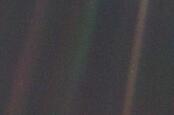This article is more than 1 year old
In case you want to flee this wretched Earth, 139 minor planets were spotted at the outer reaches of our Solar System. Just an FYI...
Too bad they are likely uninhabitable
Astronomers have discovered 139 minor planets lurking at the edge of the Solar System after examining a dataset collected to study dark energy in the universe.
Small worlds that circle our Sun in orbits further out than Neptune are labelled trans-Neptunian objects (TNO), with one being the relegated-planet Pluto. Eggheads, led by those at the University of Pennsylvania (UPenn) in the US, identified 316 TNOs in the dark-energy dataset, of which 139 bodies were previously unknown. That's according to a study published in The Astrophysical Journal this week.
Specifically, the dataset features images snapped by the Dark Energy Survey (DES), a project that used the Victor M. Blanco Telescope at the Cerro Tololo Inter-American Observatory in Chile to study the role of dark energy in the universe’s rate of expansion. The pictures were taken of the southern hemisphere for six years, from 2013 to 2019.
“The number of TNOs you can find depends on how much of the sky you look at and what’s the faintest thing you can find,” said Gary Bernstein, co-author of the study and a Professor of Astronomy and Astrophysics at UPenn.
Unlike stars or supernovas, TNOs don’t emit a lot of light. The trick to spotting TNOs among all the other stuff in the images is to look for things that move across the night sky. TNOs orbit the Sun whereas stars and distant galaxies appear more fixed. “Dedicated TNO surveys have a way of seeing the object move, and it’s easy to track them down,” said Pedro Bernardinelli, first author of the paper and a graduate student at UPenn. “One of the key things we did in this paper was figure out a way to recover those movements.”
The academics began with seven billion objects in the DES dataset. After they removed static objects – things that appeared in the same spot on multiple nights – they were left with a list of 22 million transient objects.

'That's here. That's home. That's us': It's 30 years since Voyager 1 looked back and squinted at a 'Pale Blue Dot'
READ MOREEach one looks like a dot, and the goal was to track each dot as it traveled across the sky to see if it really was an individual object. That narrowed the list down to 400 candidates that warranted further study and verification.
“We have this list of candidates, and then we have to make sure that our candidates are actually real things,” Bernardinelli said. They then realized 316 of the 400 candidates were TNOs – and 139 of that 316 were previously undetected minor worlds.
The boffins only rifled through four years’ worth of data, and they believe that, by using their method, many more TNOs can be uncovered in the future.
“There are lots of ideas about giant planets that used to be in the solar system and aren’t there anymore, or planets that are far away and massive but too faint for us to have noticed yet,” said Bernstein. “Making the catalog is the fun discovery part. Then when you create this resource; you can compare what you did find to what somebody’s theory said you should find.” ®
